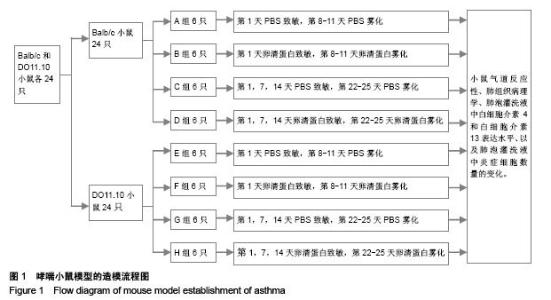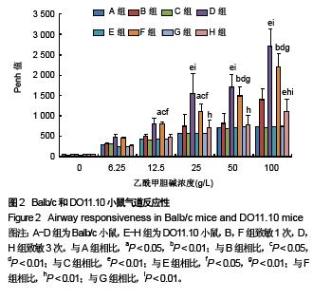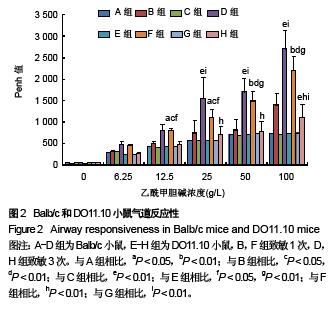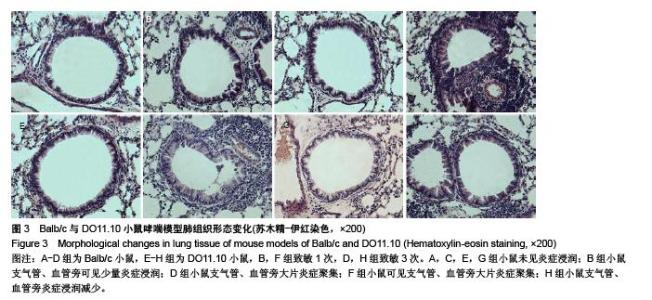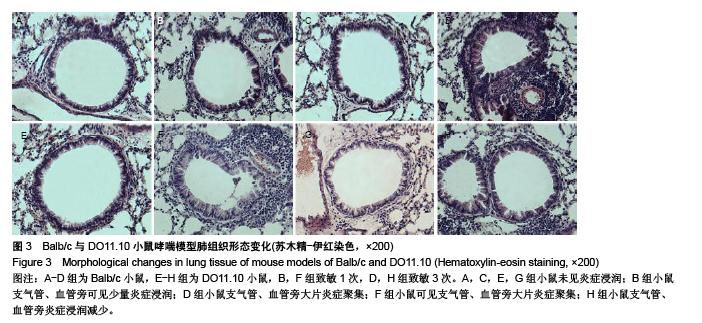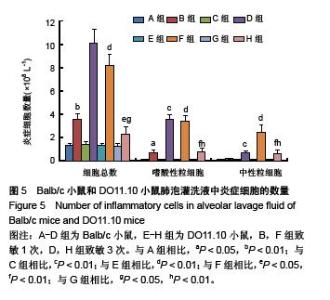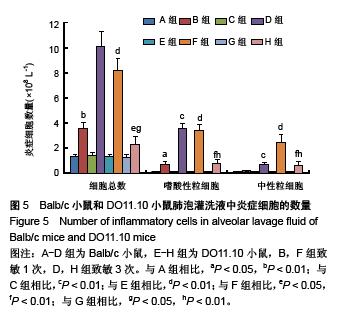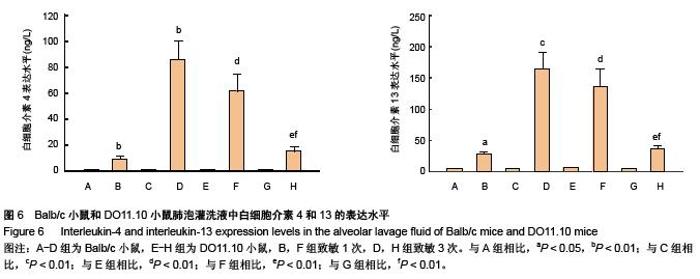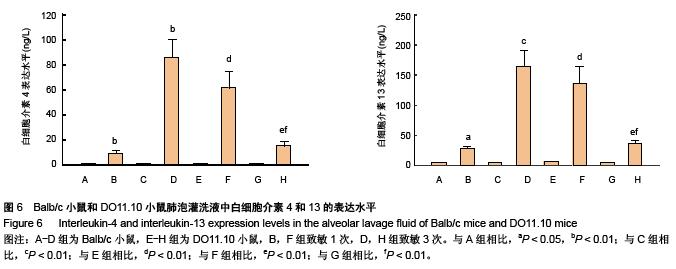Chinese Journal of Tissue Engineering Research ›› 2015, Vol. 19 ›› Issue (49): 7914-7919.doi: 10.3969/j.issn.2095-4344.2015.49.008
Previous Articles Next Articles
Establishment of an asthma model in Balb/c and DO11.10 mice
Deng Xue-quan1, 2, Yao Yin1, 2, Guo Jie-bo1, Gao Wen-xiang1, 2, Sun Yue-qi1, 2, Fu Qing-ling1, 2
- 1Otorhinolaryngology Hospital, The First Affiliated Hospital, Sun Yat-sen University, Guangzhou 510080, Guangdong Province, China; 2Otorhinolaryngology Institute, Sun Yat-sen University, Guangzhou 510080, Guangdong Province, China
-
Received:2015-10-14Online:2015-11-30Published:2015-11-30 -
Contact:Fu Qing-ling, Otorhinolaryngology Hospital, The First Affiliated Hospital, Sun Yat-sen University, Guangzhou 510080, Guangdong Province, China; Otorhinolaryngology Institute, Sun Yat-sen University, Guangzhou 510080, Guangdong Province, China -
About author:Deng Xue-quan, Studying for master’s degree, Otorhinolaryngology Hospital, The First Affiliated Hospital, Sun Yat-sen University, Guangzhou 510080, Guangdong Province, China; Otorhinolaryngology Institute, Sun Yat-sen University, Guangzhou 510080, Guangdong Province, China -
Supported by:the National Natural Science Foundation of China, No. 81170896; the Science and Technology Foundation of Guangdong Province of China, No. 2012B031800045
CLC Number:
Cite this article
Deng Xue-quan, Yao Yin, Guo Jie-bo, Gao Wen-xiang, Sun Yue-qi, Fu Qing-ling. Establishment of an asthma model in Balb/c and DO11.10 mice[J]. Chinese Journal of Tissue Engineering Research, 2015, 19(49): 7914-7919.
share this article
| [1] Kupczyk M, Wenzel S. U.S. and European severe asthma cohorts: what can they teach us about severe asthma? J Intern Med. 2012;272(2):121-132. [2] Galli SJ, Tsai M, Piliponsky AM. The development of allergic inflammation. Nature. 2008;454(7203):445-454. [3] Papaioannou AI, Kostikas K, Zervas E, et al. Control of asthma in real life: still a valuable goal? Eur Respir Rev. 2015;24(136): 361-369.[4] Fahy JV. Type 2 inflammation in asthma--present in most, absent in many. Nat Rev Immunol. 2015;15(1):57-65. [5] 施焕中.正确认识和合理应用支气管哮喘的动物模型[J].中华结核和呼吸杂志,2005,28(11):749-750.[6] Sun YQ, Deng MX, He J, et al. Human pluripotent stem cell-derived mesenchymal stem cells prevent allergic airway inflammation in mice. Stem Cells. 2012;30(12): 2692-2699. [7] Chen ZG, Zhang TT, Li HT, et al. Neutralization of TSLP inhibits airway remodeling in a murine model of allergic asthma induced by chronic exposure to house dust mite. PLoS One. 2013;8(1):e51268.[8] Kips JC, Anderson GP, Fredberg JJ, et al. Murine models of asthma. Eur Respir J. 2003;22(2):374-382.[9] Boverhof DR, Billington R, Gollapudi BB, et al. Respiratory sensitization and allergy: current research approaches and needs. Toxicol Appl Pharmacol. 2008;226(1):1-13.[10] Finkelman FD, Wills-Karp M. Usefulness and optimization of mouse models of allergic airway disease. J Allergy Clin Immunol. 2008;121(3):603-606.[11] Bullone M, Lavoie JP. Asthma "of horses and men"--how can equine heaves help us better understand human asthma immunopathology and its functional consequences? Mol Immunol. 2015;66(1):97-105.[12] Marcelino MY, Fuoco NL, de Faria CA, et al. Animal models in chronic obstructive pulmonary disease-an overview. Exp Lung Res. 2014;40(6):259-271.[13] Fricker M, Deane A, Hansbro PM. Animal models of chronic obstructive pulmonary disease. Expert Opin Drug Discov. 2014;9(6):629-645.[14] Pérez-Rial S, Girón-Martínez Á, Peces-Barba G. Animal models of chronic obstructive pulmonary disease. Arch Bronconeumol. 2015;51(3):121-127.[15] Mullane K, Williams M. Animal models of asthma: reprise or reboot? Biochem Pharmacol. 2014;87(1):131-139.[16] Wright D, Sharma P, Ryu MH, et al. Models to study airway smooth muscle contraction in vivo, ex vivo and in vitro: implications in understanding asthma. Pulm Pharmacol Ther. 2013;26(1):24-36. [17] Nakajima H. Murine asthma model. Arerugi. 2010;59(11): 1539-1545.[18] Chen T, Xiao L, Zhu L, et al. Anti-Asthmatic Effects of Ginsenoside Rb1 in a Mouse Model of Allergic Asthma Through Relegating Th1/Th2. Inflammation. 2015;38(5): 1814-1822.[19] Guest IC, Sell S. Bronchial lesions of mouse model of asthma are preceded by immune complex vasculitis and induced bronchial associated lymphoid tissue (iBALT). Lab Invest. 2015;95(8):886-902.[20] Nie H, Yang Q, Zhang G, et al. Invariant NKT cells act as an adjuvant to enhance Th2 inflammatory response in an OVA-induced mouse model of asthma. PLoS One. 2015; 10(4): e0119901.[21] [Zhang R, Kubo M, Murakami I,et al. l-Arginine administration attenuates airway inflammation by altering l-arginine metabolism in an NC/Nga mouse model of asthma. J Clin Biochem Nutr. 2015;56(3):201-207.[22] Hegazy AN, Klein C. Ex vivo priming of CD4 T cells converts immunological tolerance into effective antitumor immunity in a murine model of acute lymphoblastic leukemia. Leukemia. 2008;22(11):2070-2079.[23] Nakagome K, Matsushita S, Nagata M. Neutrophilic inflammation in severe asthma. Int Arch Allergy Immunol. 2012; 158 Suppl 1:96-102.[24] 韩灵,孙悦奇,付清玲,等.呼吸道变应性炎性反应小鼠模型的建立[J].中华耳鼻咽喉头颈外科杂志,2013,48(3):224-228.[25] Gueders MM, Paulissen G, Crahay C, et al. Mouse models of asthma: a comparison between C57BL/6 and BALB/c strains regarding bronchial responsiveness, inflammation, and cytokine production. Inflamm Res. 2009;58(12):845-854.[26] Zhang Y, Zhang L, Wu J, et al. Heme oxygenase-1 exerts a protective role in ovalbumin-induced neutrophilic airway inflammation by inhibiting Th17 cell-mediated immune response. J Biol Chem. 2013;288(48):34612-34626.[27] Takagi R, Kawano M, Nakagome K, et al. Wogonin attenuates ovalbumin antigen-induced neutrophilic airway inflammation by inhibiting th17 differentiation. Int J Inflam. 2014;2014:571508. |
| [1] | Chen Ziyang, Pu Rui, Deng Shuang, Yuan Lingyan. Regulatory effect of exosomes on exercise-mediated insulin resistance diseases [J]. Chinese Journal of Tissue Engineering Research, 2021, 25(25): 4089-4094. |
| [2] | Chen Yang, Huang Denggao, Gao Yuanhui, Wang Shunlan, Cao Hui, Zheng Linlin, He Haowei, Luo Siqin, Xiao Jingchuan, Zhang Yingai, Zhang Shufang. Low-intensity pulsed ultrasound promotes the proliferation and adhesion of human adipose-derived mesenchymal stem cells [J]. Chinese Journal of Tissue Engineering Research, 2021, 25(25): 3949-3955. |
| [3] | Yang Junhui, Luo Jinli, Yuan Xiaoping. Effects of human growth hormone on proliferation and osteogenic differentiation of human periodontal ligament stem cells [J]. Chinese Journal of Tissue Engineering Research, 2021, 25(25): 3956-3961. |
| [4] | Sun Jianwei, Yang Xinming, Zhang Ying. Effect of montelukast combined with bone marrow mesenchymal stem cell transplantation on spinal cord injury in rat models [J]. Chinese Journal of Tissue Engineering Research, 2021, 25(25): 3962-3969. |
| [5] | Gao Shan, Huang Dongjing, Hong Haiman, Jia Jingqiao, Meng Fei. Comparison on the curative effect of human placenta-derived mesenchymal stem cells and induced islet-like cells in gestational diabetes mellitus rats [J]. Chinese Journal of Tissue Engineering Research, 2021, 25(25): 3981-3987. |
| [6] | Hao Xiaona, Zhang Yingjie, Li Yuyun, Xu Tao. Bone marrow mesenchymal stem cells overexpressing prolyl oligopeptidase on the repair of liver fibrosis in rat models [J]. Chinese Journal of Tissue Engineering Research, 2021, 25(25): 3988-3993. |
| [7] | Liu Jianyou, Jia Zhongwei, Niu Jiawei, Cao Xinjie, Zhang Dong, Wei Jie. A new method for measuring the anteversion angle of the femoral neck by constructing the three-dimensional digital model of the femur [J]. Chinese Journal of Tissue Engineering Research, 2021, 25(24): 3779-3783. |
| [8] | Meng Lingjie, Qian Hui, Sheng Xiaolei, Lu Jianfeng, Huang Jianping, Qi Liangang, Liu Zongbao. Application of three-dimensional printing technology combined with bone cement in minimally invasive treatment of the collapsed Sanders III type of calcaneal fractures [J]. Chinese Journal of Tissue Engineering Research, 2021, 25(24): 3784-3789. |
| [9] | Qian Xuankun, Huang Hefei, Wu Chengcong, Liu Keting, Ou Hua, Zhang Jinpeng, Ren Jing, Wan Jianshan. Computer-assisted navigation combined with minimally invasive transforaminal lumbar interbody fusion for lumbar spondylolisthesis [J]. Chinese Journal of Tissue Engineering Research, 2021, 25(24): 3790-3795. |
| [10] | Hu Jing, Xiang Yang, Ye Chuan, Han Ziji. Three-dimensional printing assisted screw placement and freehand pedicle screw fixation in the treatment of thoracolumbar fractures: 1-year follow-up [J]. Chinese Journal of Tissue Engineering Research, 2021, 25(24): 3804-3809. |
| [11] | Shu Qihang, Liao Yijia, Xue Jingbo, Yan Yiguo, Wang Cheng. Three-dimensional finite element analysis of a new three-dimensional printed porous fusion cage for cervical vertebra [J]. Chinese Journal of Tissue Engineering Research, 2021, 25(24): 3810-3815. |
| [12] | Wang Yihan, Li Yang, Zhang Ling, Zhang Rui, Xu Ruida, Han Xiaofeng, Cheng Guangqi, Wang Weil. Application of three-dimensional visualization technology for digital orthopedics in the reduction and fixation of intertrochanteric fracture [J]. Chinese Journal of Tissue Engineering Research, 2021, 25(24): 3816-3820. |
| [13] | Sun Maji, Wang Qiuan, Zhang Xingchen, Guo Chong, Yuan Feng, Guo Kaijin. Development and biomechanical analysis of a new anterior cervical pedicle screw fixation system [J]. Chinese Journal of Tissue Engineering Research, 2021, 25(24): 3821-3825. |
| [14] | Lin Wang, Wang Yingying, Guo Weizhong, Yuan Cuihua, Xu Shenggui, Zhang Shenshen, Lin Chengshou. Adopting expanded lateral approach to enhance the mechanical stability and knee function for treating posterolateral column fracture of tibial plateau [J]. Chinese Journal of Tissue Engineering Research, 2021, 25(24): 3826-3827. |
| [15] | Zhu Yun, Chen Yu, Qiu Hao, Liu Dun, Jin Guorong, Chen Shimou, Weng Zheng. Finite element analysis for treatment of osteoporotic femoral fracture with far cortical locking screw [J]. Chinese Journal of Tissue Engineering Research, 2021, 25(24): 3832-3837. |
| Viewed | ||||||
|
Full text |
|
|||||
|
Abstract |
|
|||||
